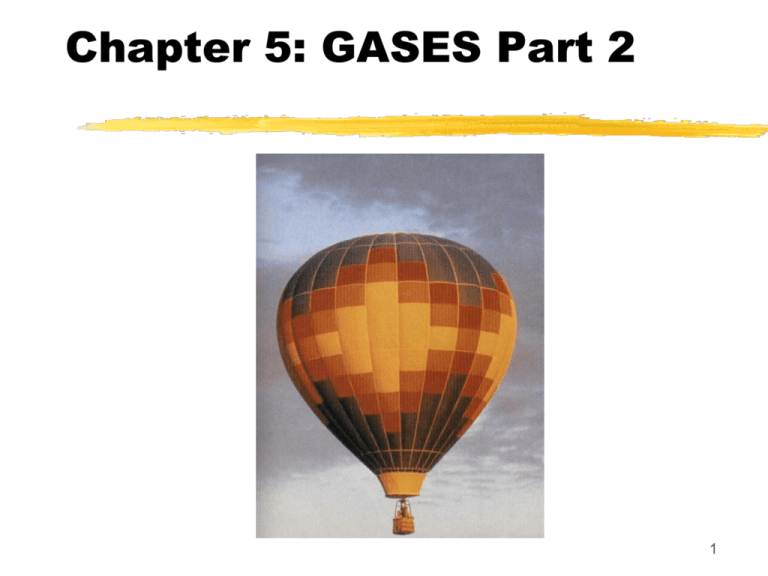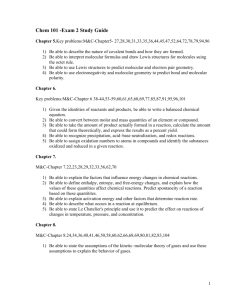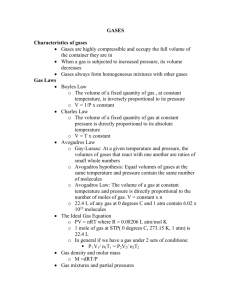A Gas
advertisement

Chapter 5: GASES Part 2 1 Things to remember 1 atm = 760 mm Hg = 760 torr PV = nRT 𝑃1 𝑉1 𝑃2 𝑉2 = 𝑇1 𝑇2 STP conditions – 1 atm and 0°C 1 mol of a gas occupies a volume of 22.4 L at STP conditions. 2 Gas Stoichiometry Example 5.12 CaO is produced by the thermal decomposition of calcium carbonate. Calculate the volume of CO2 at STP produced when 152 g of CaCO3 decomposes. 3 Limiting Reagent Stoich 5.13 A sample of methane gas (CH4) having a volume of 2.80 L at 25° C and 1.65 atm was mixed with a sample of oxygen gas having a volume of 35.0 L at 31° C and 1.25 atm. The mixture was then ignited to form carbon dioxide and water. Calculate the volume of CO2 formed at a pressure of 2.50 atm and a temperature of 125° C. 4 Molar Mass of a Gas n = grams of gas / molar mass P = nRT / V = (grams)RT / (molar mass)V AND d = mass / V SO P = dRT / molar mass Rearranged: Molar mass = dRT / P 5 Dalton’s Law of Partial Pressures Since gas molecules are so far apart, we can assume that they behave independently. Dalton’s Law: in a gas mixture, the total pressure is the sum of the partial pressures of each component: PTotal = P1 + P2 + P3 + . . . 6 Using Dalton’s Law: Collecting Gases over Water Commonly we synthesize gas and collect it by displacing water, i.e. bubbling gas into an inverted container 7 Using Dalton’s Law: Collecting Gases over Water To calculate the amount of gas produced, we need to correct for the partial pressure of water: Ptotal = Pgas + Pwater 8 Using Dalton’s Law: Collecting Gases over Water Example 3: Mixtures of helium and oxygen are used in scuba diving tanks to help prevent “the bends”. For a particular dive, 46 L of He at 25°C and 1.0 atm and 12 L of O2 at 25°C and 1.0 atm were each pumped into a tank with a volume of 5.0 L. Calculate the partial pressure of each gas and the total pressure in the tank at 25°C 9 Kinetic Molecular Theory Developed to explain gas behavior 1. Gases consist of a large number of molecules in constant motion. 2. Volume of individual particles is zero. 3. Collisions of particles with container walls cause pressure exerted by gas. 4. Particles exert no forces on each other. 5. Average kinetic energy Kelvin temperature of a gas. 10 Kinetic Molecular Theory As the kinetic energy increases, the average velocity of the gas increases 11 Kinetic Molecular Theory: Applications to Gases As volume of a gas increases: the KEavg of the gas remains constant. the gas molecules have to travel further to hit the walls of the container. the pressure decreases 12 Kinetic Molecular Theory: App’s to Gases (continued) If the temperature increases at constant V: the KEavg of the gas increases there are more collisions with the container walls the pressure increases 13 Kinetic Molecular Theory: App’s to Gases (continued) effusion is the escape of a gas through a tiny hole (air escaping through a latex balloon) the rate of effusion can be quantified 14 Kinetic Molecular Theory: App’s to Gases (continued) The Effusion of a Gas into an Evacuated Chamber15 Kinetic Molecular Theory: App’s to Gases (continued) Diffusion: describes the mixing of gases. The rate of diffusion is the rate of gas mixing. Diffusion is slowed by gas molecules colliding with each other. 16 Real Gases Real Gases do not behave exactly as Ideal Gases. For one mole of a real gas, PV/RT differs from 1 mole. The higher the pressure, the greater the deviation from ideal behavior 17 Real Gases 18 Real Gases The assumptions of the kinetic molecular theory show where real gases fail to behave like ideal gases: The molecules of gas each take up space The molecules of gas do attract each other Chemists must correct for non-ideal gas behavior when at high pressure (smaller volume) and low temperature (attractive forces become important). 19







